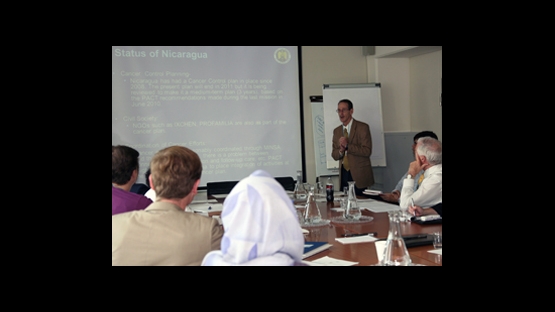A more comprehensive approach to controlling and fighting cancer is needed in many countries, according to independent cancer experts, and IAEA's Programme of Action for Cancer Therapy (PACT) is helping to raise awareness and mobilize resources.
Professor Ed Trapido from the USA and Professor Robert Burton from Australia emphasized the importance of a comprehensive approach to cancer control at a recent meeting held at IAEA headquarters in Vienna, Austria from 16-17 August 2011. The meeting was part of an ongoing effort to monitor the effectiveness of IAEA support in PACT Model Demonstration Sites (PMDS), which are currently set up in eight countries around the world.
The PMDS approach enables the integration of multiple disciplines into a coordinated and cooperative effort to address cancer prevention and control in any country committed to fighting cancer. This provides Member States with an excellent opportunity to maximize the effectiveness and sustainability of nuclear applications within their current health systems. The selection of countries has been based on requests from Member States and a thorough analysis of many factors, including the implementation of a successful cancer-related technical cooperation programme with the Agency and maintaining a high priority for cancer control in their work with the World Health Organization (WHO).
Professor Trapido, an Associate Dean for Research at Louisiana State University, recently visited five of the eight PMDS, namely, Albania, Nicaragua, Sri Lanka, Tanzania and Vietnam. During his visits, Mr. Trapido evaluated PMDS's current progress and advised the Agency in the development and implementation of short- to medium term indicators for measuring the efficiency and effectiveness of PACT activities related to PMDS.
"There needs to be strong leadership in the country in terms of cancer control," he said. "Ideally this is someone in government or the Ministry of Health who believes that cancer can become a bigger burden and is committed to developing a programme to prevent, detect and treat the disease."
Professor Robert Burton, Public Health and Cancer Control specialist at Monash University in Melbourne, Australia, is of the same opinion.
"In order to make radiotherapy and the IAEA's role most effective in cancer control, there needs to be a government-endorsed comprehensive plan that covers prevention, early detection and screening, diagnosis, treatment, all the way to palliation," Professor Burton stated.
"Without government motivation or a national plan in cancer control, efforts of the IAEA would not be as effective as they could be," he added.
In the two-day meeting, both experts also shared their evaluations of the effectiveness and impact of PDMS with cancer experts from the IAEA. They praised PACT's achievements and identified the challenges of the PMDS projects.
"PACT does not have a big budget, but it has mobilized many times its [regular] budget for its projects through successful outreach to non-traditional donors, making a great contribution to these countries," Professor Burton said.
For his part, Professor Trapido identified several positive developments since the launch of the PMDS approach.
"Progress was visible in all the activities of the PMDS. All countries with demonstration sites were able to develop effective plans for early cancer detection and better treatment opportunities. Progress in palliation and the development of cancer registry systems was also remarkable," he said.
PACT is also playing a vital role in helping countries mobilise resources and capabilities to implement a comprehensive cancer program, according to Prof. Robert Burton
"The main contribution of the project is PACT's on-going commitment to cancer control. The IAEA is constantly motivating the governments of the countries to get their cancer control plan completed and implemented and encourage national experts to collaborate. This is invaluable."
One of the great successes of PACT has been the IAEA's recognition as a unique global player and contributor to cancer control efforts in poor countries, he said.
Background
PACT Model Demonstration Sites, or PMDS, promote cross-sectorial partnerships between health ministries, national counterparts and international development partners in cancer prevention, early detection, diagnosis and treatment and palliative care. Launched as part of PACT's growing public-private partnerships, PMDS are enabling the Member States involved to combine the individual strengths and resources of the Ministries of Health and their national counterparts, WHO and IAEA/PACT, and other partners and stakeholders to achieve maximum impact on any priority interventions included in the national cancer control plan. PMDS projects are expected to help mobilise new resources for cancer control and the improvement of the infrastructures that support it. Each operational PMDS is a demonstration of the feasibility and value of multidisciplinary, interagency cooperation in combating cancer, thereby increasing the understanding and expertise of low- and middle income countries in cancer capacity building.
PDMS project are running in Albania, Ghana, Mongolia, Nicaragua, Sri Lanka, Tanzania, Vietnam and Yemen.
Since 2009, the IAEA has invited several external experts to monitor and evaluate the progress of PMDS, as part of continuing efforts to help define important indicators for moving forward.


